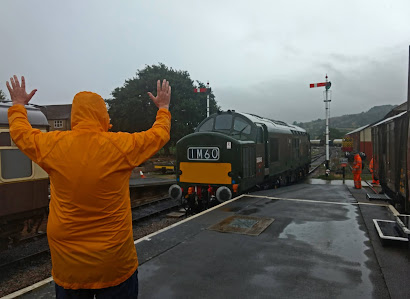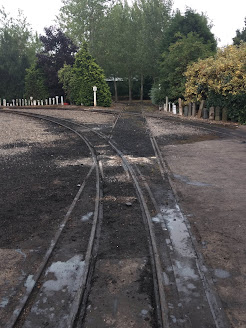Saturday with the Transits.
Now that we have nearly completed the asset removal exercise, we feel more comfortable in talking about it - there's just one more load to go.
The station we visited was Swanbourne. It's a stop on the former Varsity line from Oxford to Cambridge, which was closed and partially lifted. It is now to be reinstated, and stage 1, from Oxford to Bicester, is up and running. Swanbourne is a rural station on stage 2 of the project, from Bicester to Bletchley.
Swanbourne village is about 2 miles from its station, so it is not proposed to reinstate the stop here.
The buildings in the picture, the stationmaster's house and wooden booking office in front, will be demolished.
Here is our Transit on a test run.
It has taken us a long time to secure formal permission to work here, and part of that process was to work out how we would do the job and how easy / difficult it would be.
What we were after are these special bricks, blue bull-nosed and diamond cut edging bricks.
We need about 250 of them to complete the Usk goods platform at Winchcombe. Although we have a few in stock, and we knew the sources of a few more, what we didn't have was one source of the same type of brick to cover the whole requirement. The are not all the same size and shape!
Eventually we came to an agreement with the people rebuilding the line, as the re-use of some 12 tons of material that would otherwise be crushed or go to landfill helped to meet their goals of reducing the environmental impact. There are indeed 800 of these bricks, and each weighs 15 kilos.
Here is the trackbed at Swanbourne, seen during one of the earlier exploratory visits. One track is still down, but cut off at the far end. The bricks in question are all along the edge here, on both sides.
The length of platform nearest to the building has these stone blocks along the edge. It looks like these are the original edging stones, and that the platform was later lengthened.
These natural stones are 50cm in length, and 25cm x 25cm in section. There are 100 of them. As far as we know they are going to landfill, so if anybody can re-use them, we could provide the contact that we know.
 |
| Rails now lifted... |
Our test day involved knocking off bricks to see how easy it was, and how long it took. Some were very easy, and could be tipped back by hand, while others were sheer murder as bedded on very strong cement.
The little bolster in the picture is wedged under a pair and nothing was moving despite a real pounding with the lump hammer. If they are all like that, we have a problem. Then Roger came along a few yards further on and just tipped over a whole stretch without any tools at all...
 | |
| Phew! |
This is what a full Transit looks like - just the one layer. Knowing that a reclaimed imperial blue can cost you £1 from a reclamation yard, you can get a pretty good idea of the value of 800 of these giant blues for the platform edges.
They all need the old mortar chipping off though, that's another long job.
Someone has already made a start, but who is this masked mortar chipper?
We have no idea.When we have done that we can make a start on the building itself.
The other 500 bricks will go into our strategic store, and would be perfect to go round the future turntable pit. That will need between 400 and 500 of these bricks, so the numbers are just right.
We left behind the little booking office, all locked up and with a hole in the roof.
We did not manage to look inside, but someone else did a couple of years ago, and he made this video:
Wednesday
First time back on the Usk project! At last. But there were just 3 of us, three others being detained for various medical reasons.
The PWay gang on the other hand had a good turnout, and can be seen here in a 'socially distanced' briefing in the car park.
The circle was so big that it hindered the incoming traffic! Various hold ups ensued, as if people hadn't had enough on the A46.
Project leader Dave made it in though, and it was good to see some bricks going down again. We've got two courses left to do on the platform, then all the edging bricks to place, so a start on the actual building this year looks a bit unlikely, after the 6 month hiatus we've had.
We received a visit from Dave and Alan out of Churchward house, and they made good use of the nearly finished new platform to wave at the first train today.
The trains were well filled today, although we heard that there is still quite a bit of room for the bank holiday weekend.
After making up a barrow of mortar for Dave to lay the bricks, yours truly joined John here to start work on cleaning the 300 edging bricks that we have dropped off on the Usk hut pad.
It was quite peaceful, plugging away at the mortar all day. It came off quite well, and it was nice to be able to stack them without the stack going wobbly because they were now clean. The clean ones are stacked bottom right on the picture.
Dave could only do half a day - domestic arrangements overruling any extension - so we plugged away for the rest of the afternoon, interrupted only by the second service arriving from Toddington. Again, that was well frequented, although once again little demand seemed to be made on the offer of catering supplies being delivered to your seat directly from the Coffeepot. Strange.
Dinmore Manor was doing the honours today, a 6 coach train being a fine piece of work for her.
Then it was back to work on the edging blocks. Mortar needs to be removed from two sides and most of the bottom (some were not very well mortared down at Swanbourne and came away easily, while others were stuck down so hard the block stripped the top off the underlying brick, rather than give up its hold on the mortar.)
This is a typical brick which needed cleaning.
We made ourselves little 4ft high platforms on which to work without bending over. After doing this for an hour or two, it caused us to respect the work done at Broadway where every one of 10.000s of bricks in the platform were cleaned individually by the stalwart few.
Here's an end of the day shot of John, looking pleased with himself after counting all the bricks we had cleaned - there were 40 of them. He's sitting on the pile of clean ones. More next week.
Finally at the end of the afternoon Dinmore Manor came by again from Cheltenham, on its last journey back for the day. Then Winchcombe fell silent, except for the bell signals with which the signalman closed down his box for the day. Ting Ting.....
Neal's father
Some of you might have read between the lines that Neal came a little less often to Broadway these last few months. This was because he spent more and more time looking after his father, who was frail and increasingly unable to take care of himself. Neal would arrive late, or go home early to cook, and some days he couldn't make it to Broadway at all. Father and son shared their house for a lifetime, and after Neal's mother died a few years back, son looked after father as best as he could.
Now Neal's father Barlow has died. He passed away on August 6th and the funeral was yesterday. Barlow made it to the respectable age of 97 and was the doyen of his village. Apart from military service he never left the place of his birth.
 |
| Barlow Cooper, 1922 - 2020. |
The only departure from home ground was during military service, when he was sent overseas to Capetown, India, Iraq (Basra and Baghdad), Jordan and finally to the island of Sicily. Most of his duties were as a motorcycle dispatch rider. On his return to the UK he had a bad prang and spent a lot of time in hospitals and convalescent homes, finishing the war on lighter duties on firing ranges in Wales.
After his demob, Barlow worked for a local building firm, before becoming a railwayman at Honeybourne, where he worked as a shunter in the 1950s. He then qualified as a signalman, and worked the boxes at Honeybourne Loop, Long Marston, Milcote and Chipping Campden, all local stations now long closed.
In his latter days he was a caretaker in his local school, and after retirement he made bird feeders which he sold from his front gate, a figure at the roadside fondly remembered by the local villagers.
Barlow Cooper,
1922 - 2020
Rest in Peace.




















































































